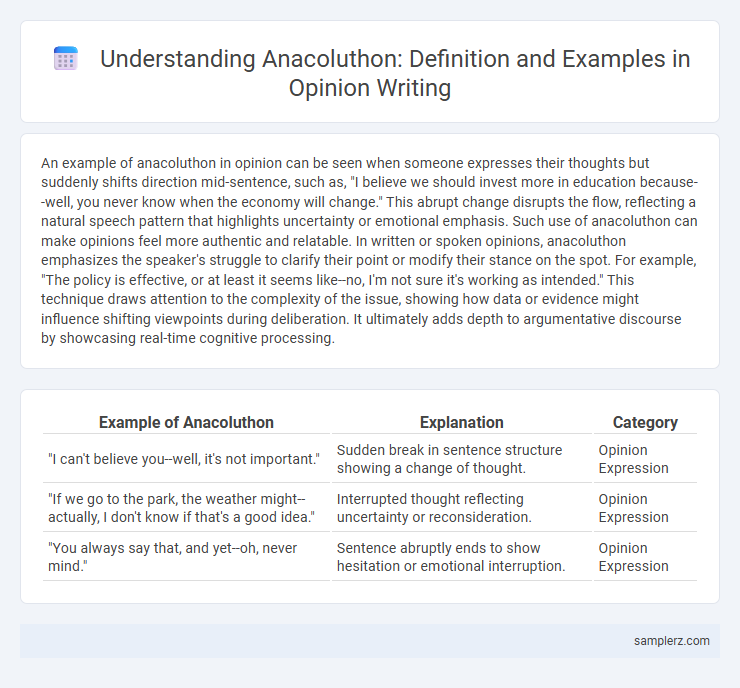An example of anacoluthon in opinion can be seen when someone expresses their thoughts but suddenly shifts direction mid-sentence, such as, "I believe we should invest more in education because--well, you never know when the economy will change." This abrupt change disrupts the flow, reflecting a natural speech pattern that highlights uncertainty or emotional emphasis. Such use of anacoluthon can make opinions feel more authentic and relatable. In written or spoken opinions, anacoluthon emphasizes the speaker's struggle to clarify their point or modify their stance on the spot. For example, "The policy is effective, or at least it seems like--no, I'm not sure it's working as intended." This technique draws attention to the complexity of the issue, showing how data or evidence might influence shifting viewpoints during deliberation. It ultimately adds depth to argumentative discourse by showcasing real-time cognitive processing.
Table of Comparison
| Example of Anacoluthon | Explanation | Category |
|---|---|---|
| "I can't believe you--well, it's not important." | Sudden break in sentence structure showing a change of thought. | Opinion Expression |
| "If we go to the park, the weather might--actually, I don't know if that's a good idea." | Interrupted thought reflecting uncertainty or reconsideration. | Opinion Expression |
| "You always say that, and yet--oh, never mind." | Sentence abruptly ends to show hesitation or emotional interruption. | Opinion Expression |
Defining Anacoluthon in Opinion Writing
Anacoluthon in opinion writing occurs when the sentence structure is abruptly interrupted, reflecting a shift in thought or emotion that mirrors natural speech patterns. This stylistic device captures the writer's spontaneous reaction, enhancing the authenticity and emotional impact of the opinion. Recognizing anacoluthon helps readers identify moments where the writer's perspective or argument pivots unexpectedly, adding depth to the subjective expression.
The Role of Anacoluthon in Expressing Personal Views
Anacoluthon serves as a powerful rhetorical device in expressing personal views by disrupting conventional sentence structure, mirroring spontaneous thought patterns and emotional intensity. This technique reflects authentic voice and internal conflict, often highlighting uncertainty or emphasis in opinionated discourse. By breaking syntactic expectations, anacoluthon draws attention to the speaker's genuine perspective, enhancing engagement and relatability in subjective communication.
Classic Examples of Anacoluthon in Opinion Columns
Classic examples of anacoluthon in opinion columns reveal a deliberate break in syntax that mirrors the writer's evolving thought process, enhancing emotional intensity and authenticity. Famous opinion writers like Charles Dickens and Virginia Woolf use anacoluthon to capture spontaneous reflections, making their arguments more relatable and vivid. This stylistic choice disrupts conventional sentence flow to emphasize subjective experience and human complexity in persuasive writing.
How Anacoluthon Enhances Subjective Narratives
Anacoluthon disrupts conventional sentence structure, reflecting the natural flow of human thought and emphasizing the speaker's emotional intensity or hesitation. This rhetorical device enhances subjective narratives by conveying confusion, passion, or spontaneity, making opinions feel more authentic and relatable. Writers and speakers use anacoluthon to mirror cognitive shifts, thereby deepening the audience's engagement with the subjective perspective presented.
Famous Opinion Pieces Featuring Anacoluthon
Famous opinion pieces often employ anacoluthon to mirror the writer's spontaneous thought process, enhancing authenticity and emotional intensity. For example, Virginia Woolf's essays exhibit interrupted syntax that reflects the flux of modern consciousness. Such stylistic choices engage readers by conveying complexity in personal reflection and argumentation.
The Impact of Anacoluthon on Audience Persuasion
Anacoluthon disrupts sentence structure, creating a sense of spontaneity that can enhance the speaker's authenticity and emotional appeal, making the opinion more persuasive. This rhetorical device engages the audience by reflecting natural speech patterns, which fosters relatability and strengthens the connection between speaker and listener. By interrupting expectations, anacoluthon encourages deeper attention and emotional involvement, amplifying the overall impact of the argument.
Common Anacoluthon Patterns in Editorials
Common anacoluthon patterns in editorials frequently involve abrupt shifts in sentence structure that disrupt the expected grammatical flow, reflecting the writer's emotional intensity or evolving thought process. These shifts often occur when an author interrupts a sentence to emphasize a particular opinion or to address a different aspect of the argument without returning to the original syntax. Examples include starting a sentence to state a viewpoint and suddenly changing direction to introduce a related but distinct idea, highlighting the persuasive and informal tone typical of editorials.
Anacoluthon as a Tool for Authentic Expression
Anacoluthon serves as a powerful tool for authentic expression by reflecting the natural flow of thought and emotional turbulence within an opinion. Writers use this technique to break conventional sentence structures, thereby capturing spontaneity and inner conflict, which adds depth and realism to their perspectives. The abrupt shifts or interruptions reveal genuine human experience, making opinions more relatable and impactful.
Mistakes to Avoid with Anacoluthon in Opinions
When using anacoluthon in opinion writing, avoid confusing sentence structures that disrupt clarity and weaken your argument. Mistakes such as abrupt shifts without resolution leave readers puzzled and undermine your credibility. Ensure smooth transitions and logical coherence to maintain a compelling and persuasive narrative.
Crafting Your Own Anacoluthon in Opinion Writing
Crafting your own anacoluthon in opinion writing enhances rhetorical impact by intentionally disrupting grammatical flow to mirror genuine thought processes. This technique captures readers' attention through unexpected shifts, emphasizing key points in a persuasive manner. Employing anacoluthon strategically enriches the voice and emotional resonance of opinion pieces, making arguments more memorable and engaging.

example of anacoluthon in opinion Infographic
 samplerz.com
samplerz.com